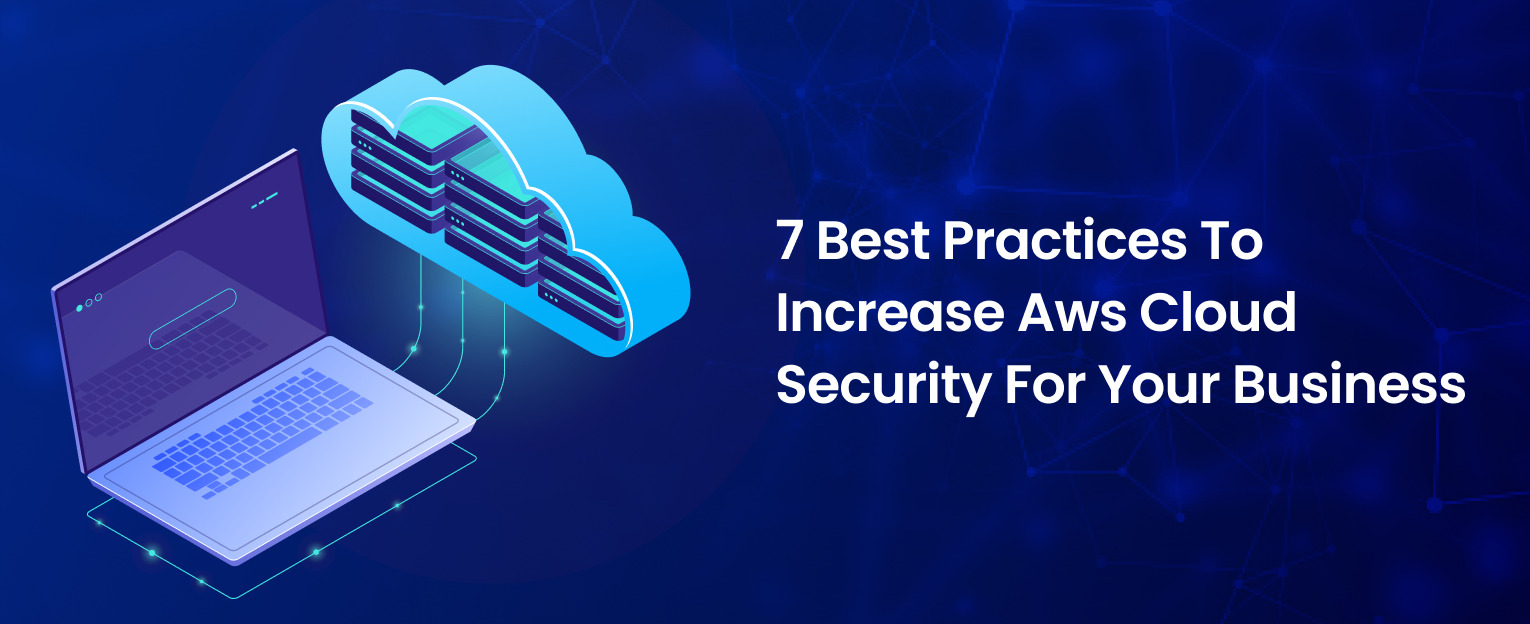It is high time for businesses to become proficient in cloud implementations, migrations, and cost and time-effectively safeguarding their cloud infrastructure.
With AWS, businesses increase their transparency and confidence in offering the best cloud computing environment possible. Additionally, they feel secure knowing that their data is safeguarded by fundamental security and compliance rules with AWS cyber security.
- The increasing dependence on the cloud for a variety of business operations has made it essential for organizations to focus on security.
- Data breaches, malware attacks, and unauthorized access can seriously harm companies that are not properly protected.
AWS provides users with a wide range of security tools and services to help strengthen their AWS cloud security.
Understanding the best practices of amazon server security can help you stay ahead of the curve. In this blog, we’ll discuss AWS best security practices for increasing your AWS cloud security and providing your business with the peace of mind that your data is safe and secure.
What is AWS Cloud Security?
AWS Cloud Security is the combination of processes, AWS security tools, and policies used to protect AWS cloud-based resources and applications. AWS also provides a variety of compliance and governance services to help organizations meet their security, privacy, and compliance requirements.
How Secure is AWS?
Is AWS secure is one of the common concerns of the users. AWS data center security is based on a shared responsibility model, which means that AWS is responsible for the security of the cloud infrastructure, while customers are responsible for securing their own applications and data.
AWS provides a wide range of security capabilities and services that can be used to protect customer data and applications. These include identity and access management (IAM) services, encryption services, network security services, and a variety of compliance services.
AWS also works hard to ensure that the physical security of its data centers is robust. AWS data centers are regularly audited and monitored, and they are designed to withstand physical and cyber-attacks.
Security on AWS comprises a combination of automated and manual processes to ensure the availability of its services. This includes continuous monitoring, automated patching, and regular security reviews. Nevertheless, switching to AWS or any other public cloud provider entails additional dangers. Each cloud environment has different difficulties.
You can not merely use your current security procedures to make AWS secure. AWS may be as safe as any other network if you know how to secure AWS, are aware of the peculiarities of cloud security, and follow the best strategies.

bOOST YOUR AWS CLOUD SECURITY WITH OUR EXPERT BEST PRACTICES
Protect your business with our AWS cloud security best practices. Learn how to precent data breaches and secure your cloud infrastructure.
7 Ways to Improve AWS Cloud Security
AWS cloud security is critical to protect the data and infrastructure of organizations that use AWS services. Employing practices to improve AWS cloud security will help organizations protect their data and infrastructure from unauthorized access, malicious activity, and data breaches.
Also, it is essential to ensure the confidentiality, integrity, and availability of data and resources by employing security best practices. Here is the AWS security best practices checklist. Let’s have a detailed look at each strategy to ensure AWS protection.
1. Define User Permissions & Identities
User permissions and identities are important for securing AWS and can be used to improve security.
- Create separate IAM users for each employee and assign them to specific groups with access to only the necessary resources. This ensures that each user can only access the resources they need to do their job.
- Require users to authenticate with a one-time passcode, in addition to their username and password, to gain access to AWS resources.
- Use IAM roles to grant users access to certain AWS resources without providing them with any credentials. This allows you to control which users can access what resources and limits their ability to make changes.
- Create security groups to control which IP addresses can access which resources. This allows you to create rules to give access to specific IP addresses or ranges while denying access to others.
- Monitor and record user activity on your AWS account with CloudTrail. This allows you to identify any suspicious activity and take action as needed quickly.
- Use KMS to encrypt and manage the keys used to encrypt data in your AWS environment. This ensures that only authorized users have access to the data.
2. Identify Assets
Assets are extensive and varied for any business or government organization. You may adhere to AWS best security practices by determining the assets you need to safeguard. Additionally, it will help you choose the best strategy for protecting these assets against every kind of threat.
The assets can be categorized into two groups.
The first group should comprise the vital information assets, which are frequently made up of business-related data and internally tailored procedures.
The second category includes physical infrastructure and other supporting elements for such crucial information assets. You will have the transparency required to decide what data needs to be guarded and how it can be done once these assets are correctly identified.
3. Keep Track Of Your AWS Credentials
AWS cyber security credentials that are required depend on the way of using AWS. To begin with, think about choosing a secure username and password to access the AWS Management Console. Moreover, remember that access keys are necessary to use the AWS Command Line Interface and make programmatic calls to the service.
Since 42% of data breaches are the result of stolen credentials, AWS does not allow customers to retrieve forgotten or stolen passwords.
As a result, if you are the root user, you must keep your AWS account ID, password, access keys, and related email address in a protected area.
The root user may reliably carry out routine AWS actions by setting up an IAM user with administrator capabilities because they are only available to the root user.
You will have numerous AWS credentials if you have multiple AWS accounts. To guarantee that such credentials are suitably protected and kept private, further care must be taken on the part of the root user.
4. Understand The Impact Incident Response Has On Corporate Goals
Considering the fact that the security of your cloud environment is crucial, customers can rest assured knowing that AWS offers automatic incident response & recovery to handle security issues while also identifying their underlying causes.
AWS Cloud offers a well-established shared liability model. Users are supposed to control the security in the cloud. However, it also implies that businesses and other organizations can install the finest cloud workload protection technology that meets their needs and complies with the AWS shared responsibility model, as well as develop a security plan that best matches their company.
To satisfy your unique security requirements and create your security baseline, you may use a variety of AWS security features and AWS security tools. A little variation, such as a misconfiguration, will often call for an urgent examination.
It is crucial to grasp the fundamental principles of incident response to prepare teams for this to happen properly. To make use of the many AWS features and set up the appropriate incident response procedures needed to build from and iterate from, security and legal will have to collaborate comprehensively and be informed about these ideas.
5. Utilize Automation Tools
Focusing on the advantages of automation tools for cloud security, automation procedures go well beyond just allowing people inside an organization to handle difficult problems. For instance, a multifactor authentication system should be in operation for a root account that has been appropriately safeguarded.
The correct automation technologies may help security teams by supplying notifications that straight away bring possible theft and other events to their attention if illegal access does occur. Automated backup emergency plans are essential solutions for disaster recovery.
Most of these providers offer a high level of automation when internal automation capabilities fall short. Organizations will notice that the costs associated with on-premise recovery techniques are greatly reduced thanks to the automation built into various cloud platforms.
6. Implement a VPC
Implementing a VPC (Virtual Private Cloud) to divide public and private infrastructure is required for enterprises that operate on several servers inside their server infrastructure.
IAM rules are implemented for internal entities, such as users, with varying degrees of authentication, but having a VPC is somewhat close to the idea of IAMs. VPCs deal with the traffic entering your network.
A VPC must initially be established for businesses that want to set up networked resources under AWS. A VPC distinguishes between what your company wants and does not want on the open internet.
Databases and any subnet containing equipment with private IP addresses fall in the private category. While subnets having elastic or public IP addresses fall under the public category. Applications may operate in a secure environment after a VPC is created within your AWS environment.
7. Set Up Your Security Groups For VPC
While setting up a VPC is necessary for securing AWS infrastructure from outside threats, it cannot just be left in place. For the VPC to continue to be secure, administrators must carefully manage it. Since even while a VPC or free VPN services might prevent hackers, it must be properly managed like any other technology.
To understand their properties and realize how a virtual firewall enables users to shut down their networks and secure their resources from illegal access, it is crucial to get familiar with the fundamentals of the AWS security center.
FAQs
What is AWS?
Amazon Web Services (AWS) is a cloud computing platform from Amazon that provides services such as computing, storage, database, analytics, and more. It allows businesses to build and deploy applications and services in the cloud quickly.
What Is The Most Effective Way To Improve Security For An AWS Environment?
The most effective way to ensure security on AWS environment and to improve it is to implement a multi-layered security strategy that includes identity and access management, encryption, and logging and monitoring.
What Is The Purpose Of Improving Security For An AWS Environment?
Improving security for an AWS environment is important to protect your data and applications from unauthorized access, malicious attacks, and data breaches. It also helps ensure regulatory compliance and protect your users from potential threats.
What Is Identity And Access Management?
Identity and access management (IAM) is a set of policies and processes controlling data and application access. It includes user management, authentication, authorization, and other security controls.
Why At AWS Cloud Security Is The Highest Priority?
AWS Cloud Security is the highest priority because Amazon server security takes a comprehensive, multi-layered approach to secure its cloud infrastructure. This approach includes physical security, network security, identity and access management, data encryption, and more.
AWS data center security also provides customers with various tools and services to help them secure their data and applications, including identity and access management, encryption, logging, monitoring, and more.
We hope that the above information will help you keep you improve the security for your AWS environment. If there’s any point left, don’t hesitate to mention it in the comment section.














